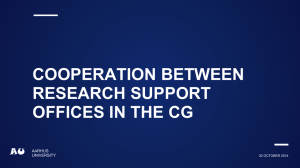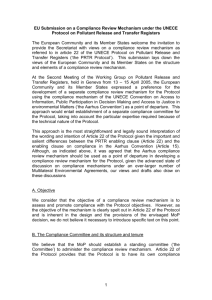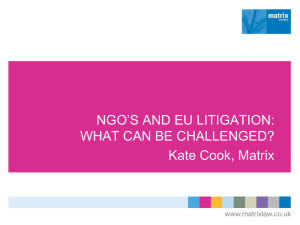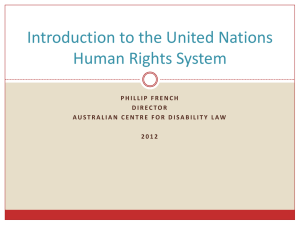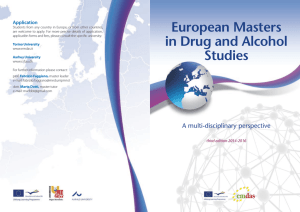Towards an ever dirtier Europe?: how the Lisbon Treaty did not
advertisement
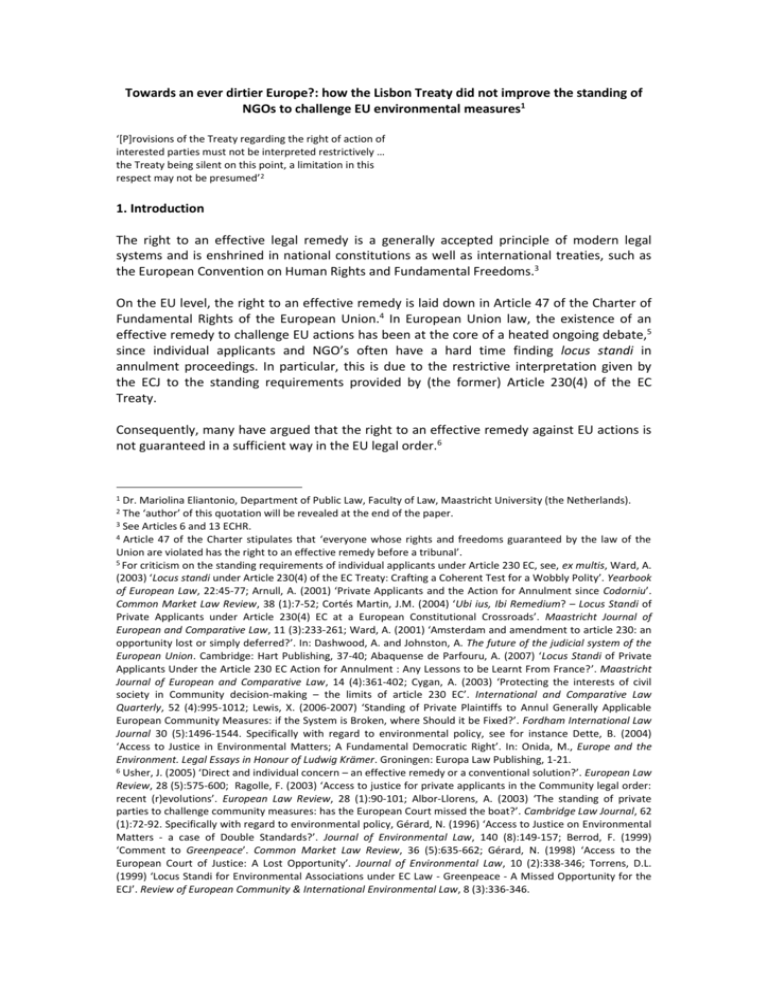
Towards an ever dirtier Europe?: how the Lisbon Treaty did not improve the standing of NGOs to challenge EU environmental measures1 ‘[P]rovisions of the Treaty regarding the right of action of interested parties must not be interpreted restrictively … the Treaty being silent on this point, a limitation in this respect may not be presumed’2 1. Introduction The right to an effective legal remedy is a generally accepted principle of modern legal systems and is enshrined in national constitutions as well as international treaties, such as the European Convention on Human Rights and Fundamental Freedoms.3 On the EU level, the right to an effective remedy is laid down in Article 47 of the Charter of Fundamental Rights of the European Union.4 In European Union law, the existence of an effective remedy to challenge EU actions has been at the core of a heated ongoing debate,5 since individual applicants and NGO’s often have a hard time finding locus standi in annulment proceedings. In particular, this is due to the restrictive interpretation given by the ECJ to the standing requirements provided by (the former) Article 230(4) of the EC Treaty. Consequently, many have argued that the right to an effective remedy against EU actions is not guaranteed in a sufficient way in the EU legal order.6 1 Dr. Mariolina Eliantonio, Department of Public Law, Faculty of Law, Maastricht University (the Netherlands). The ‘author’ of this quotation will be revealed at the end of the paper. 3 See Articles 6 and 13 ECHR. 4 Article 47 of the Charter stipulates that ‘everyone whose rights and freedoms guaranteed by the law of the Union are violated has the right to an effective remedy before a tribunal’. 5 For criticism on the standing requirements of individual applicants under Article 230 EC, see, ex multis, Ward, A. (2003) ‘Locus standi under Article 230(4) of the EC Treaty: Crafting a Coherent Test for a Wobbly Polity’. Yearbook of European Law, 22:45-77; Arnull, A. (2001) ‘Private Applicants and the Action for Annulment since Codorniu’. Common Market Law Review, 38 (1):7-52; Cortés Martin, J.M. (2004) ‘Ubi ius, Ibi Remedium? – Locus Standi of Private Applicants under Article 230(4) EC at a European Constitutional Crossroads’. Maastricht Journal of European and Comparative Law, 11 (3):233-261; Ward, A. (2001) ‘Amsterdam and amendment to article 230: an opportunity lost or simply deferred?’. In: Dashwood, A. and Johnston, A. The future of the judicial system of the European Union. Cambridge: Hart Publishing, 37-40; Abaquense de Parfouru, A. (2007) ‘Locus Standi of Private Applicants Under the Article 230 EC Action for Annulment : Any Lessons to be Learnt From France?’. Maastricht Journal of European and Comparative Law, 14 (4):361-402; Cygan, A. (2003) ‘Protecting the interests of civil society in Community decision-making – the limits of article 230 EC’. International and Comparative Law Quarterly, 52 (4):995-1012; Lewis, X. (2006-2007) ‘Standing of Private Plaintiffs to Annul Generally Applicable European Community Measures: if the System is Broken, where Should it be Fixed?’. Fordham International Law Journal 30 (5):1496-1544. Specifically with regard to environmental policy, see for instance Dette, B. (2004) ‘Access to Justice in Environmental Matters; A Fundamental Democratic Right’. In: Onida, M., Europe and the Environment. Legal Essays in Honour of Ludwig Krämer. Groningen: Europa Law Publishing, 1-21. 6 Usher, J. (2005) ‘Direct and individual concern – an effective remedy or a conventional solution?’. European Law Review, 28 (5):575-600; Ragolle, F. (2003) ‘Access to justice for private applicants in the Community legal order: recent (r)evolutions’. European Law Review, 28 (1):90-101; Albor-Llorens, A. (2003) ‘The standing of private parties to challenge community measures: has the European Court missed the boat?’. Cambridge Law Journal, 62 (1):72-92. Specifically with regard to environmental policy, Gérard, N. (1996) ‘Access to Justice on Environmental Matters - a case of Double Standards?’. Journal of Environmental Law, 140 (8):149-157; Berrod, F. (1999) ‘Comment to Greenpeace’. Common Market Law Review, 36 (5):635-662; Gérard, N. (1998) ‘Access to the European Court of Justice: A Lost Opportunity’. Journal of Environmental Law, 10 (2):338-346; Torrens, D.L. (1999) ‘Locus Standi for Environmental Associations under EC Law - Greenpeace - A Missed Opportunity for the ECJ’. Review of European Community & International Environmental Law, 8 (3):336-346. 2 With regard specifically to the challenge of EU environmental measures, one must also take the provisions of the Aarhus Convention into account. This international instrument was adopted by the European Community on 17 February 2005 by Decision 2005/370/EC7 and it provides, in Article 9(2), that the contracting parties should ensure that members of the public concerned having a sufficient interest or, alternatively, maintaining impairment of a right (where the administrative procedural law of a party requires this as a precondition), have access to a review procedure to challenge the substantive and procedural legality to decisions concerning activities subject to the public participation requirements of Article 6 of the Convention itself. Furthermore, Article 9(3) provides for the obligation for the parties to provide for a wide access of the members of the public to review procedures to challenge the legality of decisions affecting the environment. To apply the provisions of the Aarhus Convention to EC institutions and bodies, the European Community adopted Regulation No. 1367/2006 (the ‘Aarhus Regulation’).8 Specifically with regard to non-governmental organizations, the regulation allows those organizations which fulfills certain requirements9 to institute proceedings before the European Courts against the acts of EU institutions and bodies’ decisions. However, it expressly states that NGOs may do so only ‘in accordance with the relevant provisions of the EC Treaty’ (Article 12(1)).10 The aim of this paper is to show how access to justice before the EU courts for environmental NGOs has been significantly curtailed until this point in time, and discuss the changes brought to the standing test by the Lisbon Treaty, by analyzing its content and the (to this date) limited interpretation given by the European Courts to the term ‘regulatory act’ introduced by the Treaty. On the basis of this examination, it will be shown how the recent amendments have not changed the position of NGOs who wish to challenge EU environmental measures and how, therefore, a significant gap in judicial protection and a potential violation of Articles 9(2) and (3) of the Aarhus Convention still remains. 2. The limited standing of environmental NGO’s before the European courts The action for annulment, provided for in Article 263 of the Treaty on the Functioning of the European Union (TEFU), is the main mechanism for the judicial review of EU acts. This article provides that a natural or legal person may bring an action for annulment only in some specific circumstances, namely in cases of challenges against ‘decisions addressed to that person or against a decision which, although in the form of a regulation or a decision addressed to another person, is of direct and individual concern’ to the applicant. 7 Council Decision 2005/370/EC of 17 February 2005 on the conclusion, on behalf of the European Community, of the Convention on access to information, public participation in decision-making and access to justice in environmental matters [2005] OJ L 124/1. 8 Regulation 1367/2006/EC of 25 September 2006 of the European Parliament and of the Council on the application of the provisions of the Aarhus Convention on Access to Information, Public Participation in Decisionmaking and Access to Justice in Environmental Matters to Community institutions and bodies [2006] OJ L 264/13. The Regulation entered into force on 28 September 2006 and became of application on 17 July 2007. 9 Article 11 provides for certain criteria which must be fulfilled for NGO’s to initiate an internal review procedure and an action for annulment before the EU courts. 10 For a quite harsh criticism to this instrument, see Jans, J. (2006) ‘Did Baron von Munchhausen ever Visit Aarhus? Some Critical Remarks on the Proposal for a Regulation on the Application of the Provisions of the Aarhus Convention to EC Institutions and Bodies’. In Macrory, R., Reflections on 30 Years of EU Environmental Law; A High Level of Protection?. Groningen: Europa Law Publishing, 474-489. The first requirement, direct concern, is relatively straightforward compared to the requirement of individual concern.11 The ECJ has consistently found that a measure will be of direct concern to the applicant when the latter’s legal position has been directly adversely affected. In other words, there must be a direct link between the challenged measure and the loss or damage that the applicant has suffered.12 Furthermore, the Court will, with a high likelihood, deem a causation chain to be broken if the contested Community measure leaves any discretion to the addressees of the measure who are responsible for its implementation.13 The second requirement is more problematic. The ECJ laid down its view on the requirement of individual concern in the Plaumann case,14 where the Court found that ‘[P]ersons other than those to whom a decision is addressed may only claim to be individually concerned if that decision affects them by reason of certain attributes which are peculiar to them or by reason of circumstances in which they are differentiated from all other persons and by virtue of these factors distinguishes them individually just as in the case of the person addressed’. (emphasis added) This landmark case thus set the threshold for admitting individual applicants very high, by restricting the locus standi only to those persons who differentiate themselves from all other persons.15 In applying the Plaumann test, the Court has allowed standing to applicants only in exceptional circumstances, namely, where the applicant could show that it belonged to a so-called ‘closed class’, which is differently affected by the challenged measure than all other natural or legal persons.16 More specifically with regard to environmental NGO’s, the Plaumann jurisprudence was asserted for the first time in the Stichting Greenpeace Council case.17 In this case, the CFI 11 Albor-Llorens correctly notes that the lower profile of the test of direct concern is due to the fact that the ECJ has been less rigid and more consistent in the interpretation of this concept. Furthermore, since the tests of individual and direct concern are cumulative, the Court has frequently denied standing to private applicant on grounds of lack of individual concern, without even consider the requirement of direct concern. Albor-Llorens, A. (2003) ‘The standing of private parties to challenge community measures: has the European Court missed the boat?’, 75. 12 Cases 41-44/70, International Fruit Company BV v. Commission [1971] ECR 411. In this case, employees of a merging company were not granted locus standi to challenge a Commission decision allowing the merger, due to the fact that possible employment terminations would not be the direct consequence of the Commission decision. 13 See, for example, case 69/69, Alcan Aluminium Raeren v. Commission [1970] ECR 385; case 222/83, Municipality of Differdange v. Commission [1984] ECR 2889. 14 Case 25/62, Plaumann & Co v. Commission [1963] ECR 95. 15 When applied to the facts of the Plaumann case, this meant that, although the company in question was actually among the few companies importing clementines into the Community area, any person could potentially engage in such business activity. Hence, the Court found that Plaumann was not individually concerned. 16 For example, in a case concerning seven Greek cotton traders who sought judicial review of a Commission decision that authorized France to impose a fixed-term quota on cotton yarn imports from Greece to France, the Court found that pre-existing import contracts differentiated the applicant from potential importers and thus granted standing to the applicants. See case 11/82, Piraiki-Patraiki v. Commission [1985] ECR 207. The ‘closed class’ test has attracted much criticism because of its formalistic and artificial nature. See, for example, Arnull, A. (1995) ‘Private applicants and the action for annulment under Article 173 of the EC Treaty’. Common Market Law Review, 32 (1):7-50, 44-49. For a thorough review of the case law, see Arnull, A. (2001) ‘Private applicants and the action for annulment since Codorniu’, 7-50. 17 Case T-585/93, Stichting Greenpeace Council (Greenpeace International) and Others v. Commission [1995] ECR II-2205. In that case, Greenpeace International together with local associations and residents in Gran Canaria, were seeking the annulment of a decision adopted by the European Commission to disburse to the Kingdom of Spain a certain sum by way of financial assistance provided by the European Regional Development Fund for the held that the Plaumann test ‘remains applicable whatever the nature, economic or otherwise, of those of the applicants’ interests which are affected’18 and did not set up an exception for environmental matters. By applying the Plaumann test, the CFI concluded that, since the applicant association did not ‘adduce any special circumstances to demonstrate the individual interest of their members as opposed to any other person residing in those areas’19 and, therefore, [T]he possible effect on the legal position of the members of the applicant associations cannot … be any different from that alleged here by the applicants who are private individuals’,20 standing had to be refused. On appeal, the ECJ confirmed the judgment of the CFI in applying the Plaumann test.21 In particular, the ECJ was not convinced by the appellants’ plea that, ‘by applying the case-law developed by the Court of Justice in relation to economic issues and economic rights, according to which an individual must belong to a ‘closed class’ in order to be individually concerned by a Community act, the Court of First Instance failed to take account of the nature and specific character of the environmental interests underpinning their action’.22 The CFI confirmed its position in the EEB and Stichting Natuur en Milieu case.23 In this case, the EEB, a federation of over 145 environmental citizens’ organisations based in the 27 EU Member States, and Stichting Natuur en Milieu (‘SNM’), sought the annulment of some provisions of two decisions of the European Commission which allowed the Member States to maintain in force authorizations for the use of two herbicide products with potential negative effects on the environment and human health. The CFI reasserted the Plaumann jurisprudence and considered that the European Commission’s decisions affected the applicants in the same manner as any other person in the same situation and that the fact that their purpose was the protection of the environment and the conservation of nature did not establish that they were individually concerned by the decisions. It also held that the special consultative status of the EEB and of SNM with European institutions did not support the finding that they are individually concerned by the contested decisions as the Community legislation applicable to the adoption of the said decisions did not provide for any procedural guarantee for the applicants. This case was not appealed to the ECJ. The EEB case is important for two reasons. First of all, because when the Court adopted its judgment, the Aarhus Convention was already in force in the European Community. The second reason is that the CFI stressed its refusal to grant NGOs access to justice since it considered that the proposal for the Regulation that was to apply the provisions of the Aarhus Convention to the EC institutions and bodies (i.e. the Aarhus Regulation mentioned above) did not grant standing to environmental NGOs unless the latter meet the ‘individual concern’ criterion as set out in article 230 paragraph 4 of EC Treaty. construction of two power stations in the Canary Islands without first requiring or carrying out an environmental impact assessment. 18 Para. 50. 19 Para. 60. 20 Para. 60. 21 Case C-321/95 P, Stichting Greenpeace Council (Greenpeace International) and Others v. Commission [1998] ECR I-1651. 22 Para. 17. 23 Joined cases T-236/04 and T-241/04, European Environmental Bureau (EEB) and Stichting Natuur en Milieu v. Commission [2005] ECR II-04945. After the entry into force of the Aarhus Regulation, the CFI did not change its jurisprudence and instead reasserted it forcefully in the WWF-UK case.24 In this case, WWF-UK, an environmental NGO, sought the annulment in part of a Council Regulation fixing the fishing opportunities for certain fish stocks applicable in Community waters. The CFI once again concluded that the WWF-UK was not individually concerned by the contested regulation in reasserting the Plaumann jurisprudence and dismissed the action. For the purposes of this paper, it is important to point out that the CFI stated that ‘…[A]ny entitlements which the applicant may derive from the Aarhus Convention and from Regulation No 1367/2006 [i.e. the Aarhus Regulation] are granted to it in its capacity as a member of the public. Such entitlements cannot therefore be such as to differentiate the applicant from all other persons within the meaning of [the Plaumann jurisprudence]’.25 The Court thus applied the Plaumann test in the same way as it had done before, notwithstanding the approval of the Aarhus Convention by the European Community and the adoption of the Aarhus Regulation. Moreover, as in the EEB case, neither the statutory aim of the applicant NGO to protect the environment, nor its special status allowing it to participate in the decision-making process of the contested regulation were criteria considered by the Court as giving the right to challenge the contested regulation. On appeal, the ECJ confirmed the CFI’s position and, in order to support its argument, made a distinction between substance and procedure, which cannot be found in the CFI’s ruling. In particular, the ECJ agreed on the fact that, if a person is involved in the procedure leading to the adoption of a Community measure, this person is capable of distinguishing him/herself individually in relation to the measure in question if the applicable Community legislation grants him certain procedural guarantees. However, that person enjoying such a procedural right will, in the ECJ’s view, not have standing to bring proceedings contesting the legality of a Community act in terms of its substantive content. Now, according to the ECJ, the applicant association had the right to be heard by the Commission prior to the adoption of the contested Community measure; however, there was no obligation for the Community legislature to implement the proposals made in the recommendations. From this distinction, the ECJ derived the conclusion that the existence of a procedural guarantee before the Community judicature did not imply that the action was admissible as it was based on pleas alleging the infringement of substantive rules of law. The CFI confirmed this restrictive position in the Autonomous Region of the Azores case,26 in which the Autonomous Region sought the annulment in part of a regulation on the management of the fishing effort relating to Community fishing areas and resources. Three environmental associations, Seas at risk, WWF and Stichting Greenpeace Council sought leave to intervene in the case in support of the applicant. In reply to the arguments of the applicant that Article 230(4) EC should be interpreted in such a way as to render it compatible with Article 9 of the Aarhus Convention, the Court held that the Convention had not been approved by the Community when the action was brought. In addition, it recalled that Article 9 of the Aarhus Convention refers expressly to ‘the criteria, if any, laid down in [the] national law’ of the contracting parties, and that those 24 Case T-91/07, WWF-UK Ltd v. Council [2008] ECR II-81. Para. 82. 26 Case T-37/04, Região autónoma dos Açores v. Council [2008] ECR II-103. 25 criteria were laid down, with regard to actions brought before the Community judicature, in Article 230 EC. Upon this basis, the Court dismissed the action as it considered the applicant not to be individually concerned by the contested act under Article 230(4) EC. The Court acknowledged that the Aarhus Regulation allows certain NGOs to bring an action for annulment before the Community judicature. However, the court considered that the conditions laid down in that regulation were not satisfied in the present case without giving any motivation, and further deemed that ‘it is not for the Court to substitute itself for the legislature and to accept, on the basis of the Aarhus Convention, the admissibility of an action which does not meet the conditions laid down in Article 230 EC’.27 The case was appealed to ECJ, which dismissed the appeal without further discussing any point concerning the Aarhus Convention.28 3. The case law of the European Courts and the Aarhus Convention The analysis of the relevant case law shows that, in reasserting the Plaumann jurisprudence in all the cases concerning environmental matters, the European Courts have firmly refused to allow environmental NGOs to challenge decisions of EC institutions. In fact, the European Courts (the Court of First Instance and the European Court of Justice) have interpreted the individual concern criterion so narrowly (and one could argue, somewhat paradoxically)29 that environmental NGOs have in every case been refused standing to challenge EU institutions’ decisions, exempting essentially these decisions from judicial scrutiny. Apart from the Greenpeace rulings, all rulings examined above have been rendered after adoption of the Aarhus Convention by the EC. When the WWF-UK and Autonomous Region of the Azores judgments were rendered, not only was the Convention in force, but the Aarhus Regulation had been adopted. It should be noted, however, that the WWF-UK is the only case initiated after the entry in force of the Aarhus Convention in the European Community and that, to date, no ruling has been rendered in a case which has been initiated after the entry into force of the Aarhus Regulation. When the Court adopted its judgment in the EEB case, the Aarhus Convention was in force in the European Community. However, as it had not been in force when the action was initiated, the Court could not apply it. However, the Court could have been guided by the provisions and the spirit of the Convention to reconsider the standing rules and widen the access to justice for members of the public in light of Article 9 of the Aarhus Convention. The same could be argued with regard to the Autonomous Region of the Azores case, which was rendered when also the Aarhus Regulation was in force. In this case, the CFI recognised that the Community legislature adopted the Aarhus Regulation ‘in order to facilitate access to the Community judicature in environmental matters’30 and that the Regulation ‘lays down a procedure on completion of which certain NGOs may bring an action for annulment before the Community judicature under article 230 EC’.31 However, the reference to the condition ‘under article 230 EC’ and the CFI’s indication that Article 9(3) of the Aarhus Convention mentions ‘the criteria, if any, laid down in national law’ removed any possibility of an action 27 Para. 93. Case C-444/08, Região autónoma dos Açores v. Council [2009] ECR I-200. 29 The application of the Plaumann test to environmental measures has the perverse effect that, the more people are affected by EU measures (and hence, one could argue, the more potentially dangerous the EU measure is), the less the chance will be that standing will be granted. 30 Para. 93. 31 Para. 93. 28 for annulment. The CFI, indeed, considered that by the ‘criteria laid down in national law’, the interpretation of ‘individual concern’ must also be included, to the effect only the legislature could decide that article 230 EC should be interpreted differently or could amend it. In taking this position, however, the CFI did not acknowledge the findings and recommendations of the Compliance Committee of the Aarhus Convention on the Belgian Council of State, in which it stated that: ‘...the Parties may not take the clause “where they meet the criteria, if any, laid down in its national law” as an excuse for introducing or maintaining so strict criteria that they effectively bar all or almost all environmental organisations from challenging act or omissions that contravene national law relating to the environment’.32 The position of the CFI, therefore, cannot be accepted since it appears from all the case law cited that the criteria imposed by it are so strict that they bar all environmental organisations from challenging acts that are not in compliance with European law relating to the environment. From the perspective of compliance with the Aarhus convention, the outcome of the WWFUK case is even more worrying, because it demonstrates that the CFI and the ECJ continued to apply the Plaumann test notwithstanding the fact that the case was initiated after the entry into force of the Aarhus Convention. According to Article 9(2) of the Aarhus Convention, members of the public concerned do not have to have a special consultative status, as WWF-UK had, to have standing in order to challenge a decision – they must either have a sufficient interest or maintain an impairment of a right. It could be argued that, for its statutory aim and special position in the decision-making leading to the adoption of the measure it was challenging, WWF-UK had a sufficient interest. The decision of the CFI is, therefore, not in compliance with article 9(2) of the Aarhus Convention which provides that ‘what constitutes a sufficient interest and impairment of a right shall be determined in accordance with the requirements of national law and consistently with the objective of giving the public concerned wide access to justice...’. The same can be argued with regard to the ECJ’s ruling in the appeal case. Here the ECJ seemed to acknowledge that an environmental NGO which is involved with a consultative status in the process of decision-making leading to the adoption of an EC measure could be regarded as having individual concern. However, the ECJ specified that, in that case, the NGO would be regarded as having individual concern only with regard to procedural failures and not with regard to the legality of the measure in terms of its substantive content. While this ruling could be regarded as opening a door to environmental NGO’s, one immediately sees how this concession is merely formal. The only consequence it could have is to admit a challenge on procedural grounds (e.g. lack of consultation of an NGO which should have been consulted), but it would never provide the basis for a substantive challenge of a EU measure. This position is at odds with Article 9(2) of the Aarhus Convention, which prescribes the access to justice for members of the public concerned to challenge the substantive and procedural legality of a decision affecting the environment. 32 Findings and recommendations of the Compliance Committee with regard to compliance by Belgium with its obligations under the Aarhus Convention in relation to the rights of environmental organisations to have access to justice, ECE/MP.PP/C.1/2006/4/Add.2, 28 July 2006. (Para. 35) In general, it can be concluded that the European Courts seem to have ignored the requirements mandated by the Convention, since they have interpreted the criteria laid down in Article 230 EC so strictly that they bar all environmental organizations from challenging acts relating to the environment which are not in compliance with European law. This interpretation by the European Courts of the requirement of individual concern provided for in Article 230 EC does not seem to comply with the requirements of Article 9(2) and (3) of the Aarhus Convention, since the consequences of applying the Plaumann test to environmental and health issues is that in effect no NGO is ever able to challenge an environmental measure before the European Courts. The question is then whether the recognition of a broader standing for applicants would require a Treaty amendment. Despite the CFI’s opinion to the contrary in the Autonomous Region of the Azores case, it can be argued that another interpretation of the criteria laid down in Article 263(4) TFEU is definitely possible, and, in fact, required. Nothing in Article 263 suggests that if an applicant is to prove individual concern vis-à-vis a measure of general application, that person needs to prove that he is differentiated from all other persons in the same way as an addressee: the Plaumann formula, in other words, is not contained in the Treaties, but it is the European Courts’ interpretation of the phrase ‘individual concern’. The phrase itself cannot be altered by the ECJ, but changing the interpretation given to it is not something that needs to be left to the Member States, but it is the Court’s responsibility.33 4. The changes brought by the Lisbon Treaty and the (non-existent) implications for environmental NGO’s The Treaty of Lisbon modified the standing requirements for non-privileged applicants, thereby dispensing with the need to show individual concern in relation to a regulatory act that does not entail implementing measures. In particular, according to Article 263(4) TFEU, ‘[A]ny natural or legal person may … institute proceedings against an act addressed to that person or which is of direct and individual concern to them, and against a regulatory act which is of direct concern to them and does not entail implementing measures’. From an examination of this provision it seems clear that the basic policy underlying the system of judicial review has not been changed: individuals wishing to challenge acts that are not addressed to them still have to prove individual and direct concern.34 The relaxation of the standing rules will only apply to situations in which two requirements are met: first, when the measure under challenge is a regulatory act, and, second, when the measure is question does not entail implementing measures. 33 The ECJ has used the same ‘passing the hot potato back to the Member States’ technique also in the UPA case, for which it has been criticized by several scholars. See Chalmers, D. and Monti, G. (4th Ed.) (2006) European Union Law, Cambridge: Cambridge University Press, 433; Ragolle, F. (2003) ‘Access to justice for private applicants in the Community legal order: recent (r)evolutions’, 100; Tridimas, T. and Poli, S. ‘“Locus Standi” of Individuals under Article 230(4): the Return of Euridice?’. In: Tridimas, T. and Poli, S. Making community law: the legacy of Advocate General Francis Jacobs at the European Court of Justice. Celtenham: Edward Elgar Publishing, 77-99, 81; Albor-Llorens, A. (2003) ‘The standing of private parties to challenge community measures: has the European Court missed the boat?’, 90 ; Abaquense de Parfouru, A. (2007) ‘Locus Standi of Private Applicants Under the Article 230 EC Action for Annulment : Any Lessons to be Learnt From France?’, 387. On this point and specifically with regard to the compliance by the EU with its obligations stemming from Aarhus, see Pallemaerts, M. (2009) Compliance by the European Community with its obligations on access to justice as a party to the Aarhus Convention, Institute for European Environmental Policy: London/Brussels, 41. 34 Lewis, X. (2006-2007) ‘Standing of Private Plaintiffs to Annul Generally Applicable European Community Measures: if the System is Broken, where Should it be Fixed?’, 1532. These changes, however, did not have the effect of bringing the EU into compliance with its obligations under the Aarhus Convention and the added wording does not significantly change the present situation for environmental NGO’s. In order to assess the potential impact of this change, the meaning of the phrase ‘regulatory act’ must be preliminarily explained. The phrase ‘regulatory act’ is – like the amendment itself – a leftover from the Constitutional Treaty,35 although no definition of a ‘regulatory act’ can be found in either the Constitutional Treaty or the Treaty of Lisbon.36 However, in the light of the distinction made between legislative acts37 and non-legislative acts of general application,38 the latter acts can be generally regarded as ‘regulatory acts’ within the meaning of Article 263(4).39 These acts can thus certainly be implementing and delegated Regulations adopted under Articles 290 and 291(2) TFEU and possibly also Decisions of general application.40 It more doubtful, however, whether ‘regulatory acts’ include also Regulations that are adopted through a legislative procedure.41 Furthermore, the locus standi of individual applicants is broadened only with regard to regulatory acts which do not require implementing measures that is, when the applicant could only obtain access to justice by breaching the provisions of the contested measure and invoking its invalidity as a defense in criminal or administrative proceedings against him before a national court. Many environmental measures fall outside the scope of the concept of ‘regulatory act which does entail implementing measures’. First of all, a great part of EU environmental measures are adopted in the form of directives. These are acts which, regardless of their legislative or non-legislative nature, by definition entail implementing measures and thus will not be included in the measures for which, according to Article 263(4) TFEU, individual concern does not need to be proven. Secondly, even where the environmental measure is adopted by way of a decision (which was the case in the Greenpeace and EEB cases discussed above), the situation is not significantly improved for environmental NGO’s. This is because the new wording of Article 263 TFEU, read in conjunction with Article 289(3) TFEU, seems to preclude application to the Court against all decisions which were adopted by way of a legislative procedure: all 35 The Convention for the Future of Europe had taken the view that a relaxation of the test of individual concern would be desirable. See Final Report of Discussion Circle CONV 636/03. This relaxation was later introduced in Article III-270(4) of the Constitutional Treaty. For a detailed account of the alternatives considered by the Discussion Circle see Barents , R. (2004) ‘The Court of Justice in the draft Constitution’. Maastricht Journal of European and Comparative Law, 11 (2):121-141, 130. 36 Koch regards this omission as regrettable, especially because it concerns ‘a provision which directly impacts on private parties’ procedural rights’. Koch, C. (2005) ‘Locus Standi of private applicants under the EU constitution: Preserving gaps in the protection of individual’s right to an effective remedy’. European Law Review, 30 (4):511527, 520. 37 According to Article 289(3) TFEU, a legislative act is an act adopted in accordance with a legislative procedure, either with the ordinary procedure or a special legislative procedure. 38 According to Article 290(1) TFEU, ‘a legislative act may delegate to the Commission the power to adopt nonlegislative acts of general application to supplement or amend certain non-essential elements of the legislative act’. 39 Brown, C. and Morijn, J. (2004) ‘Comment on Jégo-Quéré’. Common Market Law Review, 41 (6):1639-1659, 1655. 40 Koch, C. (2005) ‘Locus Standi of private applicants under the EU constitution: Preserving gaps in the protection of individual’s right to an effective remedy’, 519-521. 41 See for a further discussion on this topic, Balthahazar, S. (2010) ‘Locus standi rule for challenges to regulatory acts by private applicants: the new art.263(4) TFEU’. European Law Review, 35 (4):542-550. decisions which are adopted by legislative procedure constitute ‘legislative acts’ and, therefore, cannot be challenged under the new wording in Article 263 TFEU. Furthermore, in case of adoption by way of a non-legislative procedure, many decisions could still not be challenged in Court under Article 263 TFEU because they would either not be qualified as regulatory acts because of the lack of general application, or because they need implementing measures at the EU or Member States’ level. Finally, where a regulation is used to issue a measure which has an effect on the environment (which was the case in the WWF-UK and Autonomous Region of the Azores cases discussed above), the loosening of the standing requirements will only take place where the regulation is not adopted with a legislative procedure and does not entail implementing measures. However, where regulations and decisions are used in the environmental field, they tend to entail a considerable number of implementing measures such as the designation of national competent authorities, the issuing of permits by national authorities, the monitoring of the respect of the provisions by the national authorities.42 They are therefore normally not directly applicable, but require implementing provisions be adopted by the EU institutions or by the EU Member States. In conclusion, one could argue that the new wording of Article 263 TFEU will only affect a small number of measures and actions taken by EU institutions or bodies. As the new text only refers to provisions of regulatory acts which do not need implementation measures, it is not likely that a significant number of EU measures that affect the environment could be challenged under the new provision. The EU courts (to date limited) interpretation given of this provision by the European Courts does not seem to alter this conclusion. In Arcelor, for example, the applicant was challenging a Directive establishing a scheme for greenhouse gas emission allowance trading within the Community.43 The General Court argued, amongst others, that the Directive could not ‘in any event, be regarded as being a regulatory act which does not entail implementing measures within the terms of the fourth paragraph of Article 263 TFEU’44 because the Member States have a broad discretion with regard to implementation of the measure. In this ruling, therefore, the accent is not so much on the scope of the concept of regulatory act, but rather on the fact that, if there are implementing measures, which is bound to be the case with Directives, individual concern will always have to be shown. The issue was raised again and became of particular significance in Inuit, in which the applicants were seeking the annulment of a Regulation concerning the trade in seal products and interim measures in the form of an order of suspension of the operation of the Regulation itself.45 In deciding on whether to grant the interim measures requested, the President of the General Court observed that the admissibility of the action of annulment could not be excluded, because it was unclear whether the Regulation at stake would qualify as ‘regulatory act’, and what the concept of ‘implementing measures’ for the purposes of Article 263(4) TFEU entailed.46 42 Jans, J. (2006) ‘Did Baron von Munchhausen ever Visit Aarhus? Some Critical Remarks on the Proposal for a Regulation on the Application of the Provisions of the Aarhus Convention to EC Institutions and Bodies’, 485. 43 Case T-16/04, Arcelor v. European Parliament and Council [2010] OJ C-100/35. 44 Para 123. 45 Case T-18/10 R, Inuit Tapiriit Kanatami and Others v. European Parliament and Council [2010] OJ C-161/41. 46 It must be pointed out that the reasoning of the President is not clear. In para. 44 it is argued that, in the context of the definition of the scope of the concept of ‘regulatory act’, ‘as the Parliament and the Council point out, that category of act would probably have to be defined in relation to that of “legislative acts”, subject to the particular circumstance, in the present case, that Regulation No. 1007/2009 was not adopted in accordance with 4. Conclusion It is the ECJ itself who has stated, in a certainly less known passage of its Plaumann ruling, that ‘[P]rovisions of the Treaty regarding the right of action of interested parties must not be interpreted restrictively … the Treaty being silent on this point, a limitation in this respect may not be presumed’.47 The analysis carried out above shows, however, that, by applying the restrictive Plaumann test to the actions brought by environmental NGO’s, the European courts have, to date, significantly curtailed access to justice to challenge EU measures affecting the environment. In fact, in none of the cases brought at the European level have environmental NGOs even been granted standing. It has also been shown that the Lisbon Treaty is unlikely to bring any significant change to the current situation, given the scope of the concept of ‘regulatory act’ which is not likely to encompass many of the environmental measures which could possibly constitute the subject matter of an action for annulment brought by NGO’s. This jurisprudence established by the ECJ (coupled with the lack of improvements brought by the Lisbon Treaty for environmental NGO’s) seems to be too strict to meet the criteria of the Aarhus Convention, as it was also recently established by the Aarhus Compliance Committee in its Draft Findings.48 While it is true that none of the cases discussed above was initiated after the entry into force of the Aarhus Regulation, it can hardly be imagined that, with the entry into force of the Regulation, a dramatic change in the case law of the European courts may be expected, as the Regulation itself make reference to the possibility for NGO’s to bring proceedings ‘in accordance with the relevant provisions of the Treaty’. On the other hand, if the examined jurisprudence of the EU Courts on access to justice were to continue, there would be a clear violation of Article 9(2) and (3) of the Convention.49 As a different interpretation of ‘individual concern’ is possible and does not require any Treaty amendment, it is submitted that the European Courts should, in order to comply with the Aarhus Convention, consider the environmental NGOs which fulfill criteria for entitlement provided by Article 11 of the Aarhus Regulation as individually concerned for the purposes of bring an annulment action against EU measures affecting the environment. Whether the European Court will, in future, interpret Article 263 TFEU more openly remains to be seen. the legislative procedure laid down in Article 294 TFEU’. This line of reasoning is not clear, given the fact that Regulation No. 1007/2009 was adopted according to Article 251 EC which equivalent to Article 294 TFEU and that this is exactly what the Parliament and the Council were arguing, as shown by para. 32 of the Order. 47 Part I. 48 Draft Findings and Recommendations of the Compliance Committee with regard to Communication ACCC/C/2008/32 concerning compliance by the European Union, available at http://www.unece.org/env/pp/compliance/Compliance%20Committee/32TableEC.htm . 49 However, it must be pointed out that the Committee noted that it considered ‘with regret that the EU Courts, despite the entry into force of the Convention, did not account for the fact that the Convention had entered into force’. (Para. 95)
